

This article is an excerpt from the Shortform book guide to "Zen And The Art Of Motorcycle Maintenance" by Robert Pirsig. Shortform has the world's best summaries and analyses of books you should be reading.
Like this article? Sign up for a free trial here .
How do you define quality? How does it work in Zen and the Art of Motorcycle Maintenance?
So, how do you define quality? In Zen and the Art of Motorcycle Maintenance, Pirsig explains that there are several phases of quality, each of which can be achieved by pursuing free and original thought.
Keep reading to find out the answer to the question “how do you define quality?”
How Do You Define Quality?
So how do you define quality? Pirsig uses Phaedrus to first discuss reasoning and logic before defining quality.
Chautauqua: Phaedrus and Quality: The First Phase
Phaedrus’s initial ideas about Quality emerged from his teaching of rhetoric. One of his students, a dutiful but not especially bright young woman, was having tremendous difficulty writing an essay. She initially wanted to write on the US, but Phaedrus recommended she narrow her focus to Bozeman, then the main street of Bozeman, and finally the front of the Bozeman Opera House, starting with a single brick. It wasn’t until she wrote about the front of the Opera House that she discovered she had something to say, and she produced 10x the words she was required to.
The student was blocked because she was trying to repeat things she’d been taught. When the topic was too broad—the US, or even Bozeman’s main street—she assumed there was something she’d learned already that could guide her, and when she couldn’t identify it she became paralyzed. When she was forced to focus on something miniscule, however, she knew nothing she’d been taught would be useful and thus resorted to her own intellectual resources.
Imitation, Phaedrus decided, was the enemy. And grades, which signified how well a student had learned to imitate what he or she had been taught, were imitation’s enabler.
So Phaedrus decided to eliminate grades.
Does this help answer the question “how do you define quality?” Not yet. Phaedrus moves onto the second phase.
Chautauqua: Phaedrus and Quality: The Second Phase
Phaedrus’s second phase began with his considering Quality outside the discipline of rhetoric. One casualty of his ideas about Quality was the entire branch of philosophy known as aesthetics—the study of beauty. Because, if Quality—which Phaedrus equated with beauty—was by definition indefinable, then defining beauty was impossible, too.
But if Quality was indefinable, how could Phaedrus be sure it existed? To answer this question, he used an approach that originated in the philosophical school of realism. Philosophical realists argued that an entity exists if, when that entity is subtracted from the world, the world can no longer function normally.
Phaedrus discovered that a world without Quality was a severely diminished one. There were no fine arts (because street noise was just as good as a symphony), no comedy (because humor depends on Quality), no sports (because the scores would be meaningless), no flavorful foods (because anything would taste like anything else), and no entertainment at all (because no one would be able to tell the difference between fun and boredom).
(Shortform note: Some of Phaedrus’s examples show circular reasoning. For example, ”the difference between humor and no humor is pure Quality.”)
Phaedrus’s conclusion was that a world could function without Quality, but it would certainly not function normally. Thus Phaedrus had proved, at least as far as the philosophical realists were concerned, that Quality existed.
In the course of his thought experiment, Phaedrus discovered that there were historical analogues to the Qualityless world he’d imagined: ancient Sparta and the totalitarian states of communist China and Russia. A Qualityless world was a utilitarian one, organized exclusively according to the laws of reason.
A Qualityless world, Phaedrus realized, was a square one. Phaedrus decided that Quality was a powerful analytical instrument. It cleaved the world cleanly in half: on one side, the terms defined by an inability to recognize Quality unless its meaning was already clear (square, classical, technological); on the other, the terms defined by their ability to recognize Quality whether its meaning was clear or not (hip, romantic, humanistic). Pirsig calls this Phaedrus’s “first wave of crystallization.” This is the first part of answering the question “how do you define quality?”
Chautauqua: Phaedrus and Quality: The Second Phase (cont’d)
The classical—or “square”—mode of understanding analyzes the world by slicing it up into pieces and then organizing those pieces into hierarchical structures. Quality, by virtue of its indefinability, eludes this procedure—it cannot be satisfactorily placed in any hierarchy.
Phaedrus believed that this aspect of Quality would lead him to a better understanding of the ghost that continued to haunt him: the ghost of rationality. It was his work in this vein that eventually caused him to lose his mind.
Defining Quality
Now that you see how Pirsig and Phaedrus reasoned through their ideas of quality, the question remains: how do you define quality? Here’s what Phaedrus says.
Different types of people have different attunements to Quality. Intellectuals, unsurprisingly, have the most difficulty apprehending Quality, because they’re so quick to classify every experience according to hierarchical structures of knowledge. Young children, on the other hand, are the most sensitive to Quality, because their structures of knowledge are far more limited than intellectuals’. In other words, the more experience we have, the less able we are to see Quality.
Now Phaedrus had his answer to why people saw Quality differently—why, for example, classical thinkers saw Quality in underlying form while romantic thinkers saw it in immediate experience. Each person brings to Quality a unique breadth of experience, which provides analogues for the Quality event. Thus the more alike people’s experience is, the more likely they are to see the same kind of Quality. This explained why Phaedrus’s composition class (mostly) agreed on which papers were Quality—they all had similar backgrounds to each other.
He was finally ready to respond formally to the objections of his colleagues. He sat down and wrote out his conclusions, which went as follows:
Quality cannot be explained by virtue of philosophy, for philosophical explanation, which distinguishes between subjects and objects, comes after the immediate, preconscious awareness of Quality.
The simplest way to think about Quality is as an organism’s response to its environment. We respond to our environment is all sorts of ways, by attempting to master it through technology and industry or represent it through the arts. But prior to these material responses, and what causes them, is our sense of Quality.
Quality cannot be defined because it transcends and gives rise to any possible definition itself. To define Quality is to mistake it.When he finished, he realized that he’d changed his position yet again: it wasn’t a trinity he was describing, but a monism (that is, a single entity, like God, that gives rise to everything there is).
He remembered that Hegel, a German philosopher, dealt with a monism called Absolute Mind. Then he recalled that Hegel was sometimes treated as a bridge between the Western and Eastern philosophical traditions. He went to his bookshelf and picked up a book he’d hand-copied years before: Lao Tzu’s Tao Te Ching. Almost as soon as he began reading he knew: The Tao (Chinese for “Way”)—the mystical generating force for all there is in the universe—was exactly what he meant by Quality!But this new awareness came at a cost. As he read, his thoughts came like a rockslide and he found himself losing control.
His discovery was too much for his mind to bear.

———End of Preview———
Like what you just read? Read the rest of the world's best book summary and analysis of Robert Pirsig's "Zen And The Art Of Motorcycle Maintenance" at Shortform .
Here's what you'll find in our full Zen And The Art Of Motorcycle Maintenance summary :
- How an unnamed narrator and his son are on a cross-country motorcycle journey
- Why technology can be creative
- How to focus on what's in front of you in order to get exactly what you need






